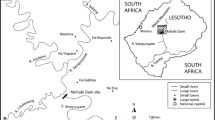Abstract
The objective of this study was to determine the bacterial contaminations in drinking water samples collected form some rural habitations of northern Rajasthan, India. A total of ten bacterial species: Escherichia coli, Pseudomonas aeruginosa, Enterobacter aerogenes, Klebsiella sp, Proteus vulgaris, Alcaligenes faecalis, Bacillus cereus, Staphylococcus aureus, Streptococcus lactis and Micrococcus luteum were identified form drinking water samples. The bacteria belonging to the family enterobacteriaceae (coliforms) showed the maximum occurrences in water samples. The total coliforms count, i.e. TTC\(^{\it m}\) (m = MPN index/ 100 ml) in drinking water samples was in the ranges of 25 TTCm (village Naiwala)–41 TTCm (village Meharwala). The data suggested that the drinking water quality deterioration in rural habitations of this region was due to poor sanitation and unawareness about personal hygienic practices. The occurrences some pathogenic bacteria in drinking water may increase the risks of water-related diseases and health problems in local residents.
Similar content being viewed by others
References
Aneja, K. R. (2004). Experiments in microbiology, plant pathology & biotechnology (4th ed.). New Delhi: New AGE International (P) Ltd. Pub.
Ashbolt, N. J. (2004). Microbial contamination of drinking water and disease outcome in developing regions. Toxicology, 198, 229–238. doi:10.1016/j.tox.2004.01.030.
Enriquez, C., Nwachuku, N., & Gerba, C. P. (2001). Direct exposure to animal enteric pathogens. Reviews on Environmental Health, 16(2), 117–131.
Planning Commission (2002). Report of the screening committee on drinking water supply & sanitation (Rural and Urban) for tenth five year plan. New Delhi, India: Planning Commission.
Pujari, P. R., Nanoti, M., Nitnaware, V. C., Khare, L. A., Thacker, N. P., & Kelkar, P. S. (2007). Effect of on-site sanitation on groundwater contamination in basaltic environment—A case study from India. Environmental Monitoring & Assessment. doi:10.1007/s10661-007-9616-3.
Greenberg, A. E., Trussell, R. R., & Clescri, L. S. (1985). Standard methods for the examination of wastewater (16th edn). APHA, AWWA, WPCF, New York, USA.
Klein, D. A., & Casida, L. E. (1967). E. coli die out from normal soil as related to nutrient availability and the indigenous microflora. Canadian Journal of Microbiology, 13, 1456–1461.
Mackie & McCartney (1996). Practical medical microbiology. In: J. G. Colle, A. G. Fraser, B. P. Marmion, & A. Simmons (Eds.), Churchill livingstone (14th edn.) New York, USA.
Tortora, G. J., Funke, B. R., & Case, C. I. (1988). Microbiology: An introduction, (3rd ed.). California, USA: Benjamin/Cumming.
Trabulsi, L. R., Keller, R., & Tardelli Gromes, T. A. (2002). Typical and atypical enteropathogenic Escherichia coli. Emerging Infectious Diseases, 8(5), 508–513.
Walsh, J. A. (1990). Estimating the burden of illness in the tropics. In K. S. Warren & A. A. F. Mahoud, (Eds.), Tropical and geographical medicines (2nd ed.) New York: Mc-Graw Hill.
WHO (World Health Organization) (1984). Guidelines for drinking water quality recommendations. Geneva: World Health Organization (WHO).
WHO (World Health Organization) (2003). Emerging issues in water and infectious disease. Geneva: World Health Organization (WHO).
Williams, S. T. (1989). Bergey’s manual of systematic bacteriology. Baltimore: Williams and Wilkins.
Yan, T., & Sadowsky, M. J. (2007). Determining sources of fecal bacteria in waterways. Environmental Monitoring & Assessment, 129(1–3), 97–106.
Author information
Authors and Affiliations
Corresponding author
Rights and permissions
About this article
Cite this article
Suthar, S., Chhimpa, V. & Singh, S. Bacterial contamination in drinking water: a case study in rural areas of northern Rajasthan, India. Environ Monit Assess 159, 43–50 (2009). https://doi.org/10.1007/s10661-008-0611-0
Received:
Accepted:
Published:
Issue Date:
DOI: https://doi.org/10.1007/s10661-008-0611-0




